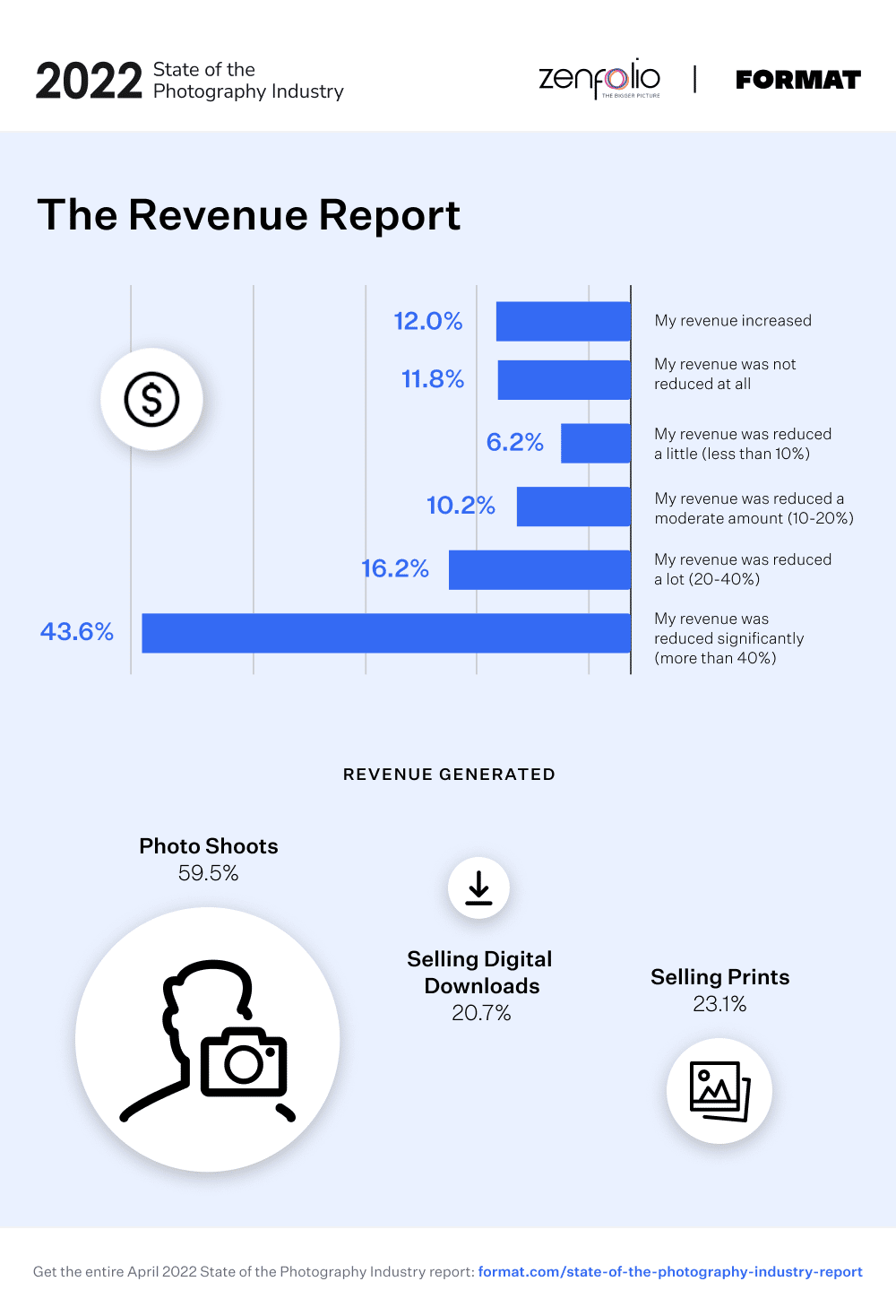The past two years in which the pandemic has dominated headlines have been tumultuous for most industries, and photography is no different. The reduced ability to conduct photoshoots in person and hesitancy on the part of clients to spend money in a time of uncertainty meant that photographers saw a general decline in revenue. Now, with restrictions being lifted and much of the world returning to in-person interactions, photographers are cautiously optimistic about their businesses.
Zenfolio and Format conducted the State of the Photography Industry Survey in February 2021, May 2021, and, most recently, in March 2022, tracking the impact of the pandemic on the photography industry by surveying more than 3,300 photographers globally. The valuable insights gleaned help to provide a big-picture overview of how photographers are ensuring continued growth in their revenues even during a time of change and uncertainty.
The data shows the resiliency of the photography industry and provides insight into how you can take action to grow your business. We’ll look at both the strategy of raising your prices and that of increasing the value you bring to your clients through your business. Implementing a combination of both can be an effective way to ensure that you’re among the photographers globally who will see an increase in revenue in 2022.
Some regular price increases are normal and expected in most industries, but in an evolving business and photography landscape, we also look at ways in which you can make yourself more valuable to your clients, ensuring long-lasting and profitable relationships. The unprecedented challenges ushered in by the pandemic also gave way to new opportunities for photographers, with ever more personal and commercial visual media being shared and consumed online. Photography is an important part of this shift, and the ongoing need for high-quality images across a range of industries makes photography a resilient profession even in times of flux.
Price Yourself for your Ideal Client
When it comes to your pricing strategy, consider the importance of pricing yourself with your target client in mind. It may be tempting to try to compete with other photographers on price, but the ultimate result of this strategy is a gradual depression of the prices that clients are willing to pay for photography
The Risk of Setting Your Photography Prices Too Low
As has always been the case with photography, it can be challenging to communicate the reason for your prices with clients. More experienced clients will understand the amount of work that goes into a successful shoot, including the investment in quality equipment, the years of expertise, and the time spent in pre and post-production. Those that don’t have a good understanding of why photographer’s rates are what they are may expect a lower rate that makes sense to them as a fair hourly amount to earn, but if you allow those expectations to dictate your pricing, it will be very difficult to be profitable.
No matter who you’re targeting, your ideal clients should understand what goes into a photography job quote, and be accepting of your rates within reason. Of course, if your ideal client is a large multinational corporation, it is reasonable for your rates to be significantly higher than if you want to cater to small businesses. Your pricing should be within the reasonable range for the ideal client you would like to work with.
By setting your prices too low, you’re not only setting yourself up for insufficient revenue for the work that you do, but you’re also signaling to your ideal client, who values quality, that you might not be as good of a candidate as your competitors.


What Your Photography Rates Signal
For your ideal client, your photography rates should be a signal of the quality and value that you provide. By competing on low price, you’re devaluing your work and paradoxically may drive away high-value clients who understand the work that goes into creating quality images. The State of the Photography Industry report found that most photographers—over 75% in most industries—get their new clients by word of mouth. That means that by setting your prices too low, you’ll often be needlessly reducing your revenue when your ideal clients likely care more about the quality of work you can produce based on their friend’s recommendations than if they can shave a bit of money off their invoice. Or, if you price yourself low, and then get referrals from those clients, the referred clients will have an expectation of a similar level of investment, and then you’re stuck in a cycle of lower revenue than you would like.
Bring Value Into Your Photo Practice
Being a professional photographer is about more than just showing up to a gig, taking the photos, and delivering acceptable files on time. There are many ways you can bring more value into your photography practice, making yourself a trusted partner to your clients. The more your clients see you as a source of value to their business, the less likely they will be to shop around for other photographers. Plus, as a method of growing your business, focusing on bringing value to your photo practice will also translate into more revenue from each client. This is distinct from just raising prices. There may be times when price increases are warranted, but it’s not as simple as increasing your rates indefinitely with nothing reciprocal offered in return to your clients. So, what can bringing value into your photography practice look like? Here are some suggestions for how you can become a valuable partner in your client’s business:
Think Ahead of your Clients’ Needs
One way to show that you’re not just taking photos for your client to make a buck, but that you actually care about their personal satisfaction or the success of their business, is to take some time each quarter to look ahead and anticipate what your client’s needs may be and reach out to them with some relevant proposals or information.

For example, consider the client list of a family photographer, one of the categories of photographers that was busier than expected in 2021 according to the State of the Photography Industry report. You may have been busy with family shoots in Q4 when many families book photographers for the holidays, but January and February may be quieter. A way to add value to your clients during this time would be to send them a friendly email to say hello and share a short presentation with reference photos of springtime photo shoot ideas you’re preparing for.
You could share new seasonal props and backgrounds you’ve acquired, and offer a discount for returning or for referring other families. This shows you proactively care about them getting images they love throughout the year.
It doesn’t always have to be a sales pitch, either. You can also share some pro-photographer tips for how they can get the best images at home in between professional shoots, with posing tips or ideas for how to get little kids to sit for great photos. The occasional newsletter or direct email with this kind of information that isn’t sales-oriented helps to break up more promotional communications.
Offer Special Incentives
Depending on who your clients are, they may only have the budget for one or two major shoots per year. However, most clients would still appreciate a more scaled-down mini-offering in between shoots. For example, if you’re a product photographer, you can make the most of slow times between major marketing seasons by offering your clients mini-sessions for a few products.
You can have multiple clients send in their products, create a few reusable product photography sets, and shoot them all in a day or two. Your clients will value the special offer and the chance to get some fresh imagery without booking a whole expensive shoot, and you can have a very profitable couple of days by consolidating the preparation for many different clients into one shoot.
Become a Thought Leader
Having a presence in your field helps to establish trust and makes you more valuable to your clients. Whether you create a YouTube channel to talk about photography-related subjects relevant to your niche, keep a blog, or grow your Instagram, becoming a thought leader implicitly commands more bookings and higher rates.
Plus, if you have a sizable following, then just sharing your client work can provide some free marketing to them. For example, a fashion photographer with a large following may drive revenue to their indie clothing brand-customer by sharing their work with a fashion-loving audience. This can be extremely valuable to your clients. It also shows that you’re engaged with the industry and this will pay off in the long run.
Collect Testimonials
As the State of the Photography Industry Survey shows, word of mouth is by far the most important way photographers across various fields get new clients. Word of mouth marketing is authentic and trustworthy, so encouraging your clients to recommend you to their network and collecting testimonials to put on your portfolio website are both good habits to practice to bring more value to your photography practice.
How to Calculate Photography Pricing
Now that we’ve gone over the importance of pricing your work for your ideal client and building value into your photography practice, let’s take a look at how you can arrive at a photography pricing structure that is fair to both you and the client.
Especially for new photographers, it can be far too easy to misjudge all of the expenses and time that goes into producing an excellent photo shoot. Take these items into account to make sure that your pricing covers your expenses, time, and expertise.
Consider Your Annual Revenue Goals
A good place to start is by setting an annual goal for yourself. If you want to make $70,000 this year, how much do you have to be earning, on average, monthly? How many shoots can you reasonably book, plan for, shoot, and edit in a month? Dividing your monthly revenue goal by the number of shoots you can realistically book can give you a rough starting point of what your expectations are.
Of course, you may not be able to book as many clients as you’d like, or your annual revenue goal may be unrealistically high. In these cases, you’ll have to make adjustments, but this is still a useful starting point to define your goals. If you want to be booking $5000 jobs, you can start thinking about who those ideal clients are that have this budget, and making lists of clients to start pitching.
Know Your Fixed and Variable Costs
One of the most common mistakes early-career photographers make is neglecting to take a realistic view of what their costs of doing business are. Your fixed expenses are things like, equipment, editing, and marketing software fees, and rent if you have a permanent studio.
Your shoots should cover a portion of all of these expenses. For example, that $4000 camera may be new now, but with each shoot, it is likely to depreciate slightly. Your clients are not just paying for your labor, they are also paying for the use of your equipment. Depending on your specialty, you can have a separate line on your invoice for equipment usage which can be billed hourly or at a flat rate per shoot. Other specialties, such as family or wedding photography, would simply build this into their pricing without including a line item.
Your variable costs are those that change depending on the amount of work you do. For example, you may travel for a shoot, or have an assistant who you only hire for certain jobs. All of these should be included in the pricing for the jobs that incur those costs.
Define Your Hourly Rate
Your hourly rate should reflect your skill and expertise, as well as the degree to which you are in demand. Remember that your hours of labor do not only apply to the shoot itself, but also to the time in pre-production and editing photos.
With specialties such as portraits and weddings, the industry standard is to provide a set amount of time for a set price. For example, you may charge $450 for a one hour portrait session, or $3200 for 7 hours of wedding coverage. For commercial or product shoots, you may choose to have your hourly rate on your invoices apply only to the duration of the shoot, but make sure your line items for pre-production and editing are sufficient to cover your hourly rate for the amount of time you spend on those tasks.
Earning Photography Income During COVID
Even though the worst of the COVID pandemic may be largely in the rear-view mirror now (fingers crossed), there’s no denying that it has left its mark on the photography industry. You may have already done some of these things to earn money during the pandemic and are shifting back to your usual revenue source, but it’s always a good idea to diversify your revenue stream and implement some of these remote-friendly revenue sources into your business.

Sell Prints Online
Our State of the Photography Industry report found that next to photoshoots, the second most common way that photographers generated revenue through the pandemic is by selling prints online. Regardless of annual revenue, over 30 percent of photographers across a range of incomes listed this as one of their revenue streams.
In-person print sales, a less pandemic-friendly approach, were also reported as an income source, but it was only used by fewer than 25 percent of photographers.
Create Courses or Workshops
While fewer than 10 percent of photographers reported this income stream, it’s well worth considering. The nice thing about creating an online course or workshop is the scalability. Once you’ve created it, you can continue marketing it and selling it to new audiences well after the work of creating it is done.
Self-Publish Photo Books
For bibliophiles, self-publishing photo books can be another remote-friendly way to make money as a photographer. Art photographers, landscape photographers, and others in similar niches may sell their work in art books, while those shooting families and weddings can offer custom books from their photoshoots as revenue-boosting add-on.
Sell Digital Downloads
Digital downloads, such as Photoshop and Lightroom presets, are another scalable revenue booster. Posting these on digital marketplaces can prove very profitable even if they are inexpensive, provided that a large enough number of people are willing to pay for digital photo downloads.
How to improve your workflow
Any professional photographer can attest to the fact that sometimes the behind-the-scenes parts of photography take up the most time. Streamlining as many of the tasks involved in running your business as possible can free up valuable time and increase your ultimate hourly revenue.
Using a platform like Format provides access to a suite of valuable pro-photographer-approved tools, like built-in client invoicing, client management, contracts, and client proofing galleries that make communicating with your client base and managing your business streamlined and simple. The right software can be really helpful in improving your workflow and letting you focus on the important things, like landing your ideal clients and getting behind the camera.
So, ultimately when it comes to pricing there are pros and cons to raising your prices as a default tactic. The pandemic was tough on the photography industry, and many of us have either lost a large piece of our business or had to depart the industry altogether.
In an effort to get back to where you were pre-pandemic, to reclaim some of those lost profits, it’s easy to just say “I’ll raise up my rates a little.” Each step should be carefully considered, and your client’s needs will have to come into play. As much as raising your prices sounds like it will lead to more revenue, it’s not always the case. Making your services more valuable for your ideal clients will go a long way, and as we discussed earlier, the majority of photographers get new work by word-of-mouth. Make sure your customers feel like they are getting their money’s worth, while still delivering the stellar quality imagery you’ve perfected. Keep in mind that you can create more value for yourself as a business owner so that each dollar you need to spend to run your business goes farther. This, in turn, will lead to helping you keep your prices where they need to be for your ideal clientele, while your revenue increases.








